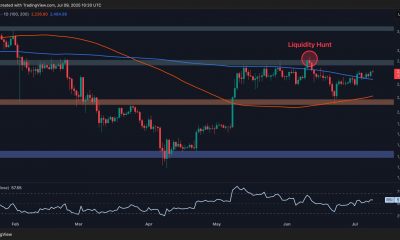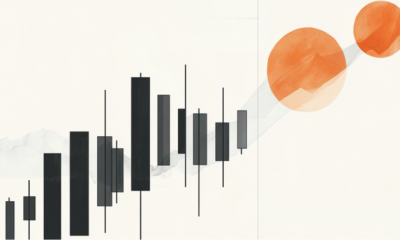

others
Major indexes open deep in the red – Crypto News
- Wall Street’s main indexes opened in negative territory on Tuesday.
- Fed Chairman will testify on the semi-annual Monetary Policy Report this week.
- Factory Orders and ISM Services PMI data will be released later in the day.
The S&P 500 (SPX) loses 0.4% at 5,109.66, the Dow Jones Industrial Average (DJIA) drops 0.35% at 38,852.09 and the Nasdaq Composite (IXIC) falls 0.85% at 16,070.17 after the opening bell on Tuesday.
Stock market news
The Technology Sector is down 1.3% as the worst-performing major S&P sector in the early trade. On the flip side, the Consumer Staples Sector is up more than 0.5%.
Target Corp. (TGT) is the biggest gainer so far on Tuesday, rising more than 11% at $167.27. Albemarle Corp. (ALB) shares are down 10% at $119.90.
Assessing the latest developments in equity markets, “the quiet start to the week for US equities did see the Magnificent 7 (-0.85%) under-perform, with slightly more moderate losses for the NASDAQ (-0.41%),” said Jim Reid, global head of economics and thematic research at Deutsche Bank, and continued:
“There were contrasting moves within the Magnificent 7, with Tesla down -7.16% amid new price cuts and discounts by EV maker, while Nvidia (+3.60%) overtook Saudi Aramco to become the third largest company in the world by market cap. On the other hand, the equal-weighted version of the S&P 500 was up +0.24% on the day, as utilities (+1.65%) and banks (+1.58%) outperformed. Back in Europe, the STOXX 600 (-0.03%) was flat on the day, but there was a noticeable underperformance from the FTSE 100 (-0.55%).”
Dow Jones FAQs
The Dow Jones Industrial Average, one of the oldest stock market indices in the world, is compiled of the 30 most traded stocks in the US. The index is price-weighted rather than weighted by capitalization. It is calculated by summing the prices of the constituent stocks and dividing them by a factor, currently 0.152. The index was founded by Charles Dow, who also founded the Wall Street Journal. In later years it has been criticized for not being broadly representative enough because it only tracks 30 conglomerates, unlike broader indices such as the S&P 500.
Many different factors drive the Dow Jones Industrial Average (DJIA). The aggregate performance of the component companies revealed in quarterly company earnings reports is the main one. US and global macroeconomic data also contributes as it impacts on investor sentiment. The level of interest rates, set by the Federal Reserve (Fed), also influences the DJIA as it affects the cost of credit, on which many corporations are heavily reliant. Therefore, inflation can be a major driver as well as other metrics which impact the Fed decisions.
Dow Theory is a method for identifying the primary trend of the stock market developed by Charles Dow. A key step is to compare the direction of the Dow Jones Industrial Average (DJIA) and the Dow Jones Transportation Average (DJTA) and only follow trends where both are moving in the same direction. Volume is a confirmatory criteria. The theory uses elements of peak and trough analysis. Dow’s theory posits three trend phases: accumulation, when smart money starts buying or selling; public participation, when the wider public joins in; and distribution, when the smart money exits.
There are a number of ways to trade the DJIA. One is to use ETFs which allow investors to trade the DJIA as a single security, rather than having to buy shares in all 30 constituent companies. A leading example is the SPDR Dow Jones Industrial Average ETF (DIA). DJIA futures contracts enable traders to speculate on the future value of the index and Options provide the right, but not the obligation, to buy or sell the index at a predetermined price in the future. Mutual funds enable investors to buy a share of a diversified portfolio of DJIA stocks thus providing exposure to the overall index.
Markets await US data, Fed Chairman Powell testimony
The US economic docket will feature January Factory Orders and February ISM Services PMI report on Tuesday.
Speaking on the policy outlook on Monday, Atlanta Federal Reserve (Fed) President Raphael Bostic said that he expects the Fed to lower the policy rate by 25 basis points twice in 2024. “Inflation is still widespread, with more than the usual share of items increasing above 5% with trimmed mean remaining stuck at 2.6%,” Bostic added, Reuters reports.
In its Semi-annual Monetary Policy Report published on Friday, the Fed reiterated that it’s not appropriate to reduce the policy rate until they have greater confidence inflation will move sustainably toward 2%.
Fed Chairman Jerome Powell will present the monetary policy report and respond to questions in a two-day testimony before the Congress, starting Wednesday.
On Friday, the US Bureau of Labor Statistics will release February jobs report, which will include Nonfarm Payrolls, the Unemployment Rate and wage inflation figures.
-
![DIS Elliott Wave technical analysis [Video]](https://dripp.zone/news/wp-content/uploads/2025/06/DIS-Elliott-Wave-technical-analysis-Video-Crypto-News-400x240.jpg)
![DIS Elliott Wave technical analysis [Video]](https://dripp.zone/news/wp-content/uploads/2025/06/DIS-Elliott-Wave-technical-analysis-Video-Crypto-News-80x80.jpg) others1 week ago
others1 week agoSkies are clearing for Delta as stock soars 13% on earnings beat – Crypto News
-
![DIS Elliott Wave technical analysis [Video]](https://dripp.zone/news/wp-content/uploads/2025/06/DIS-Elliott-Wave-technical-analysis-Video-Crypto-News-400x240.jpg)
![DIS Elliott Wave technical analysis [Video]](https://dripp.zone/news/wp-content/uploads/2025/06/DIS-Elliott-Wave-technical-analysis-Video-Crypto-News-80x80.jpg) others1 week ago
others1 week agoSkies are clearing for Delta as stock soars 13% on earnings beat – Crypto News
-

 Blockchain1 week ago
Blockchain1 week agoInsomnia Labs Debuts Stablecoin Credit Platform for Creators – Crypto News
-

 Blockchain1 week ago
Blockchain1 week agoAnt Group Eyes USDC Integration Circle’s: Report – Crypto News
-

 Cryptocurrency5 days ago
Cryptocurrency5 days agoWhale Sells $407K TRUMP, Loses $1.37M in Exit – Crypto News
-

 Cryptocurrency1 week ago
Cryptocurrency1 week agoTornado Cash Judge Won’t Let One Case Be Mentioned in Roman Storm’s Trial: Here’s Why – Crypto News
-

 Blockchain1 week ago
Blockchain1 week agoXRP Rally Possible If Senate Web3 Crypto Summit Goes Well – Crypto News
-

 others1 week ago
others1 week agoUSD/CAD trades with positive bias below 1.3700; looks to FOMC minutes for fresh impetus – Crypto News
-

 Blockchain1 week ago
Blockchain1 week agoKraken and Backed Expand Tokenized Equities to BNB Chain – Crypto News
-

 others1 week ago
others1 week agoEUR/GBP posts modest gain above 0.8600 ahead of German inflation data – Crypto News
-

 Cryptocurrency1 week ago
Cryptocurrency1 week agoBitcoin Breaks New Record at $111K, What’s Fueling the $120K Price Target? – Crypto News
-
Technology1 week ago
XRP Eyes $3 Breakout Amid Rising BlackRock ETF Speculation – Crypto News
-
Business1 week ago
PENGU Rallies Over 20% Amid Coinbase’s Pudgy Penguins PFP Frenzy – Crypto News
-

 Blockchain5 days ago
Blockchain5 days agoRobinhood Dealing With Fallout of Tokenized Equities Offering – Crypto News
-

 Cryptocurrency1 week ago
Cryptocurrency1 week agoIs ETH Finally Ready to Shoot For $3K? (Ethereum Price Analysis) – Crypto News
-

 Blockchain1 week ago
Blockchain1 week agoBinance Founder Backs BNB Treasury Company Aiming For US IPO – Crypto News
-

 Blockchain1 week ago
Blockchain1 week agoEthereum Bulls Roar — $3K Beckons After 5% Spike – Crypto News
-

 Blockchain1 week ago
Blockchain1 week agoAustralia Banks Join Digital Currency Trial for Tokenized Assets – Crypto News
-
Business1 week ago
Did Ripple Really Win XRP Lawsuit Despite $125M Fine? Lawyer Fires Back at CEO – Crypto News
-

 Cryptocurrency1 week ago
Cryptocurrency1 week agoXRP price forecast as coins surges 2.19% to $2.33 – Crypto News
-

 Metaverse1 week ago
Metaverse1 week agoHow Brands Can Deepen Customer Connections in the Metaverse – Crypto News
-

 Technology1 week ago
Technology1 week agoPerplexity launches Comet, an AI-powered browser to challenge Google Chrome; OpenAI expected to enter the space soon – Crypto News
-

 Blockchain1 week ago
Blockchain1 week agoSUI Chart Pattern Confirmation Sets $3.89 Price Target – Crypto News
-
Technology1 week ago
Breaking: SharpLink Purchases 10,000 ETH from Ethereum Foundation, SBET Stock Up 7% – Crypto News
-

 others1 week ago
others1 week agoEUR/GBP climbs as weak UK data fuels BoE rate cut speculation – Crypto News
-

 Blockchain1 week ago
Blockchain1 week agoBitcoin Hits All-Time High as Crypto Legislation Votes Near – Crypto News
-

 others1 week ago
others1 week agoAustralian Dollar remains stronger due to persistent inflation risks, FOMC Minutes eyed – Crypto News
-

 others1 week ago
others1 week agoUS Dollar Resurgence May Be Around the Corner, According to Barclays Currency Strategist – Here’s Why: Report – Crypto News
-
others1 week ago
Trump Jr. Backed Thumzup Media To Invest In ETH, XRP, SOL, DOGE And LTC – Crypto News
-

 Technology1 week ago
Technology1 week agoGoogle’s worst nightmare? OpenAI’s new AI web browser is coming soon to challenge Chrome – Crypto News
-

 Cryptocurrency1 week ago
Cryptocurrency1 week agoBitcoin Hits Record Peak. How High Can It Surge in 2025? – Crypto News
-
Technology1 week ago
VC Firm Ego Death Capital Closes $100M Funding to Back Bitcoin-Based Projects – Crypto News
-
Cryptocurrency1 week ago
Tokenized Securities Are Still Securities, US SEC Warns Robinhood, Kraken – Crypto News
-

 others1 week ago
others1 week agoNovaEx Launches with a Security-First Crypto Trading Platform Offering Deep Liquidity and Institutional-Grade Infrastructure – Crypto News
-

 others1 week ago
others1 week agoAnthony Scaramucci Says $180,000 Bitcoin Price Explosion Possible As BTC ‘Supremacy’ Creeps Up – Here’s His Timeline – Crypto News
-

 Cryptocurrency1 week ago
Cryptocurrency1 week agoBitcoin Breaks New Record at $111K, What’s Fueling the $120K Price Target? – Crypto News
-
Business1 week ago
US Senate To Release CLARITY Act Draft Next Week – Crypto News
-

 others1 week ago
others1 week ago$687,220,000 in Bitcoin Shorts Liquidated in Just One Hour As BTC Explodes To $116,000 – Crypto News
-

 Business1 week ago
Business1 week agoS&P Global Downgrades Saks Global’s Credit Rating – Crypto News
-

 Cryptocurrency4 days ago
Cryptocurrency4 days agoSatoshi-Era Bitcoin Whale Moves Another $2.42 Billion, What’s Happening? – Crypto News
-

 Technology1 week ago
Technology1 week ago10 Smartchoice tablets from top brands, curated for everyday use, up to 45% off before Amazon Prime Day Sale – Crypto News
-
others1 week ago
China’s Ant Group With 1.4B Users Taps Circle to Integrate USDC – Crypto News
-

 De-fi1 week ago
De-fi1 week agoOusted Movement Labs Co-Founder Sues Startup in Delaware Court – Crypto News
-
Business1 week ago
XRP Set for Big Week as ProShares ETF Launches July 18 – Crypto News
-
Technology7 days ago
Hyperliquid Hits Record $10.6B OI As HYPE Price Records New ATH – Crypto News
-

 Blockchain6 days ago
Blockchain6 days agoZiglu Faces $2.7M Shortfall as Crypto Fintech Enters Special Administration – Crypto News
-
Business1 week ago
XRP Open Interest Skyrockets Ahead Of ProShares XRP ETF Approval – Crypto News
-

 Blockchain1 week ago
Blockchain1 week agoAnalyst Predicts 50% “Moonshot” For XRP Price If This Line Breaks – Crypto News
-
others1 week ago
Donald Trump Pushes For A 300 Basis Points Fed Rate Cut – Crypto News
-
Technology1 week ago
Breaking: Bitcoin Price Hits New ATH Amid Trump Tariff Scare – Crypto News



![Spotify (SPOT) Elliott Wave analysis [Video]](https://dripp.zone/news/wp-content/uploads/2025/07/Spotify-SPOT-Elliott-Wave-analysis-Video-Crypto-News-400x240.jpg)
![Spotify (SPOT) Elliott Wave analysis [Video]](https://dripp.zone/news/wp-content/uploads/2025/07/Spotify-SPOT-Elliott-Wave-analysis-Video-Crypto-News-80x80.jpg)





